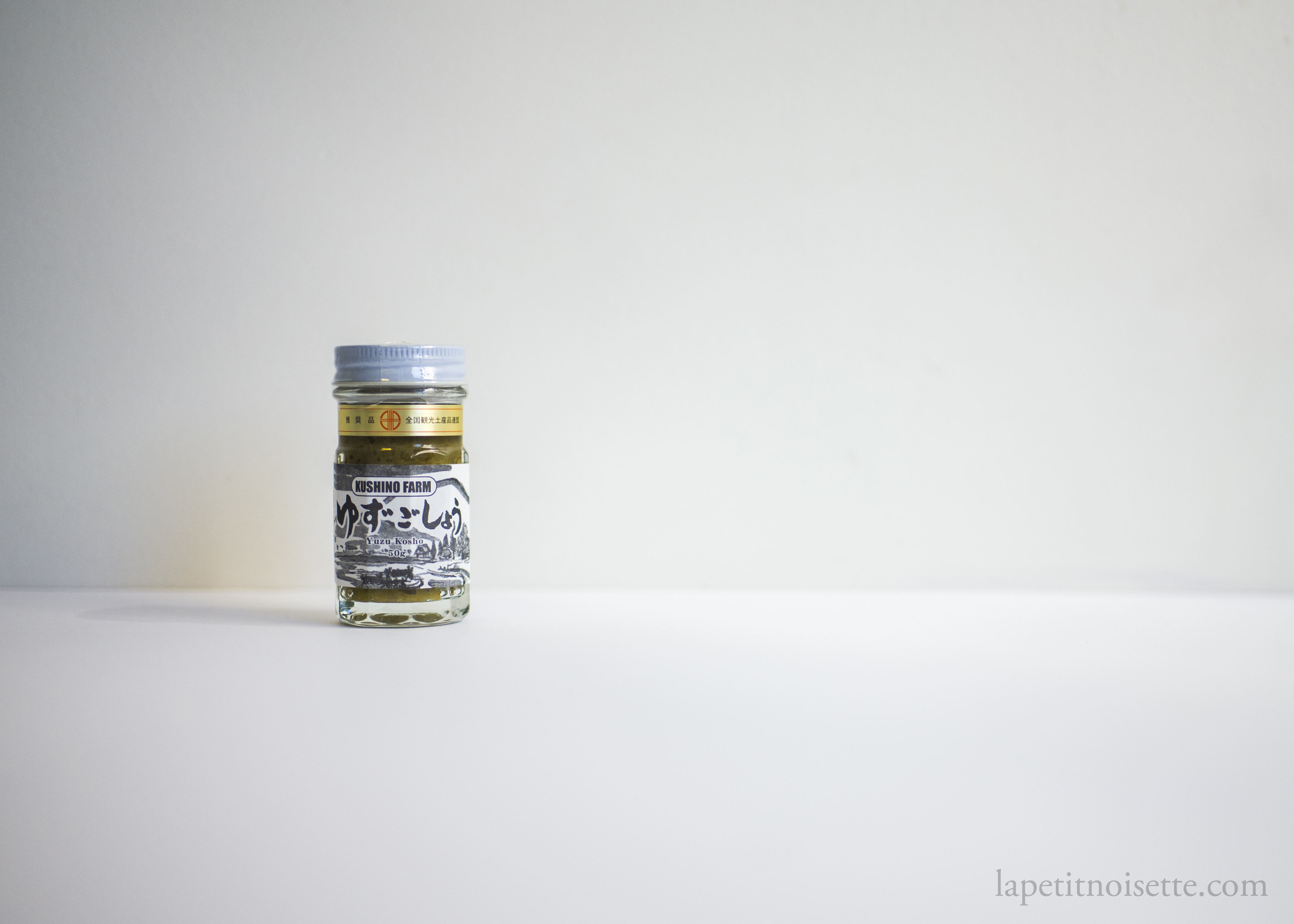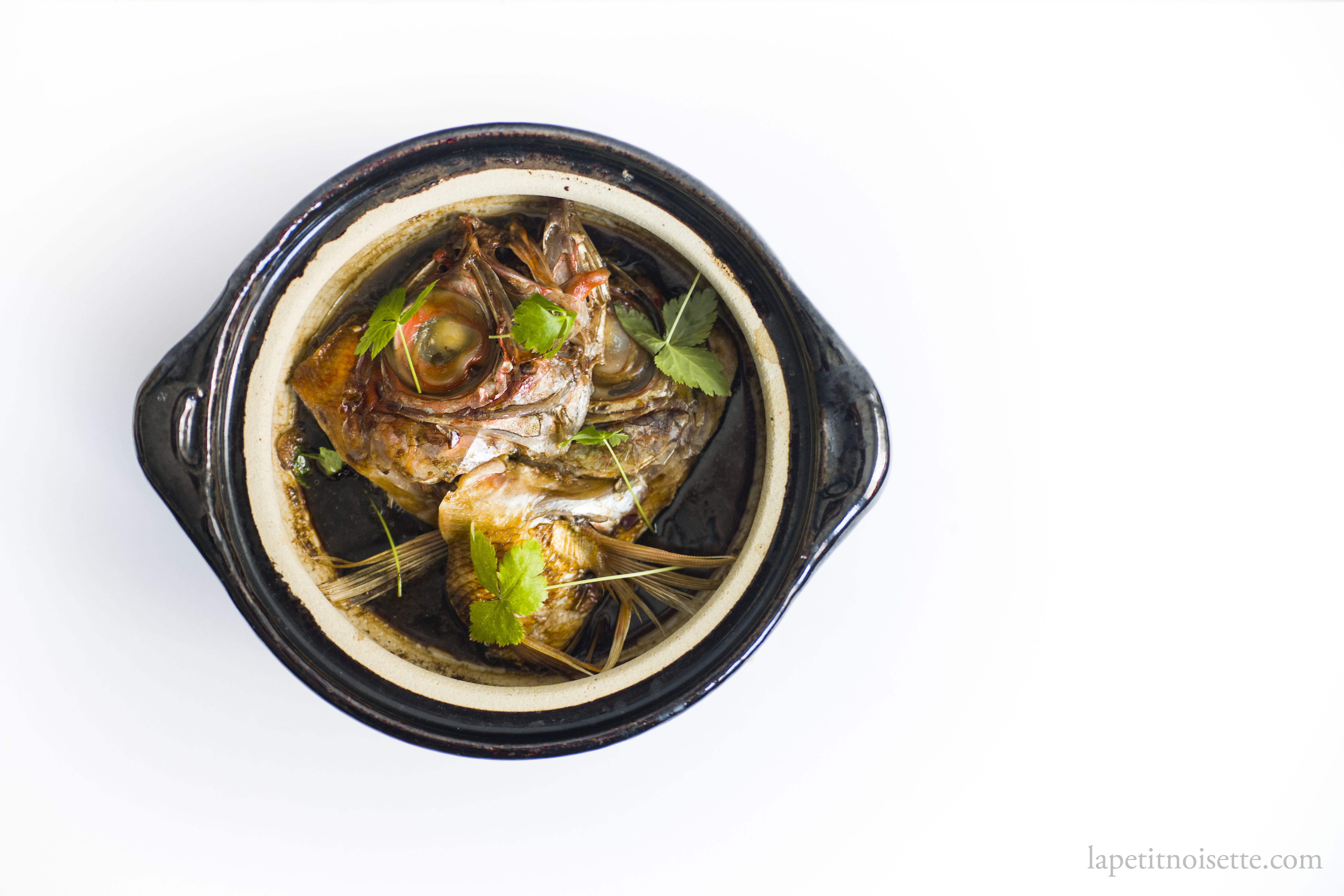
This was one of the dishes that on the few very lucky days that we had spare fish heads that did not need to be made into the day’s miso soup, we made into this dish to eat as staff meal. Even rarer however, was when the quality of the Kinmedai we received was so good that it just wasn’t worth turning the heads into stock. In this case this dish would be served to the customers, half a head each. This also required that there needed to be enough heads for 1 seating of customers that day, which in itself was quite uncommon as we were mostly delivered fresh fish everyday rather than in large batches.
The category of nimono (煮物), or simmered food in Japan is large and plays an especially important role in home cooking as a typical meal consists of soup, a simmered dish and a grilled dish. The technique of nitsuke (煮付け) falls under this category, and whilst most fish cooked this way are called soy sauce simmered dishes, I personally much more agree with Shizuo Tsuji translation of the technique as “sake-simmered”. Just like how an italian ragu is not a tomato sauce but a meat sauce flavoured with tomatoes, nitsuke dishes to me are sake (or mirin) simmered dishes flavoured with soy sauce.
As sake is such a key ingredient to use in this dish, we used a special cooking sake to elevate this dish. This particular cooking sake is called Izumo Jidenshu (出雲地伝酒) by Yoneda Sake Brewery (米田酒造株式会社), which was established in 1896, with their main brand being their Toyo no Aki (豊の秋) line of sake. Based in Shimane Prefecture (島根県), this sake went out of production during the 1930s and was only revived later by local efforts to promote local speciality products. There are multiple aspects of this sake that make it unique in taste. Firstly, it is made from a high percentage of sticky rice and. This combined with less water used in a long brewing process of 3 months, which yields a thicker and amber coloured liquid that is unlike normal clear sake. This process means that only a small production is made each year. Finally, their sake is not preserved by pasteurization, but by adding ash to increase the sake’s pH, making it more alkaline. In my opinion, it’s this addition of ash that gives this sake it’s own unique taste profile that is slightly nutty and oxidised with a sweetness from the sticky rice at the end. The brewery themselves promote this cooking sake as perfect for balancing out the fishy aroma in dishes, which is perfect for fish heads which can be particularly fishy. Due to its nutty and oxidised flavour profile, a more modest substitution for this sake is 50% cooking sake and 50% Chinese cooking wine or dry sherry. We also use the hon-mirin they produce to make ume-mirin.
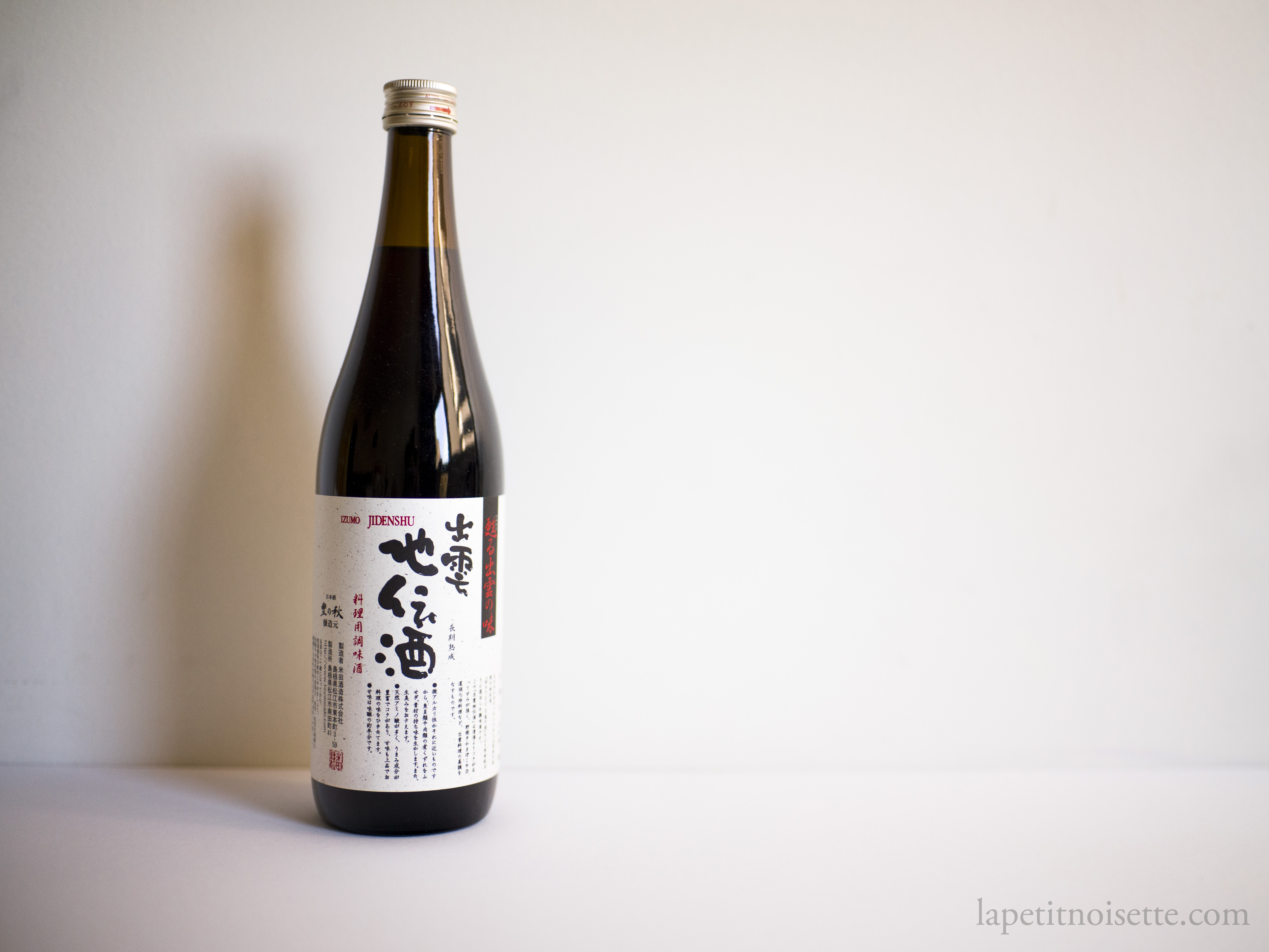
When cooking with this sake, we bring it up to a simmer before flambe-ing the vapours to burn off any alcohol. We then reduce the sake before adding the fish heads, before finally adding the soy sauce as a base flavour right at the end. The key focus here is to reduce the sake first before simmering the fish heads and adding in the soy sauce, not adding the soy sauce with the sake and reducing them together.
The technique used to cut the fish head in half is known as 兜割り (kabuto-wari) or 梨割り (nashi-wari) which is interesting because if you google kabuto-wari, you’ll find images of a person’s face cut in the wrong cross-section compared to what we want to do with the fish. This is the same technique used to prepare fish heads for akadashi miso soup. By splitting the fish into two, you reduce the thickness of the fish, allowing it to cook much faster. And this faster cooking time is crucial. If cooked over a low heat, the fish has a tendency to become chewy and rubbery, but in an almost rolling boil, the fish will become flaky.
In addition to this, you’ll want to have a Japanese drop lid, or otoshibuta (落し蓋) which allows the boiling sauce to cover the fish heads as you cook them, so that the exposed surfaces of the heads are still basted with sauce. A japanese drop lid is a lid that doesn’t cover the top of the pot, but sits inside the pot on top of the ingredients, preventing them from moving around whilst both deflecting the boiling liquid back onto the ingredients whilst allowing for some evaporation. If you don’t have one, simply fold a large sheet of aluminium into 2 layers and then fold into a disc with a diameter smaller than your pot so that it fits inside. Use a knife to poke several holes in the disc to allow some evaporation. This works with baking paper as well. Another recipe that uses this lid is our simmered sea eel.
Kinmedai head in particular has several scales near the cheeks and collars which can be hard to remove during the scaling process, even if you scale it thoroughly, as so, you’ll want to quickly blanch the fish heads in boiling water for 15 to 20 seconds each before placing them straight into an ice bath to cool. This will make it much easier to peel away any of the scales left on the head. The blanching process also lets you more easily clean away any impurities left inside the head cavity.
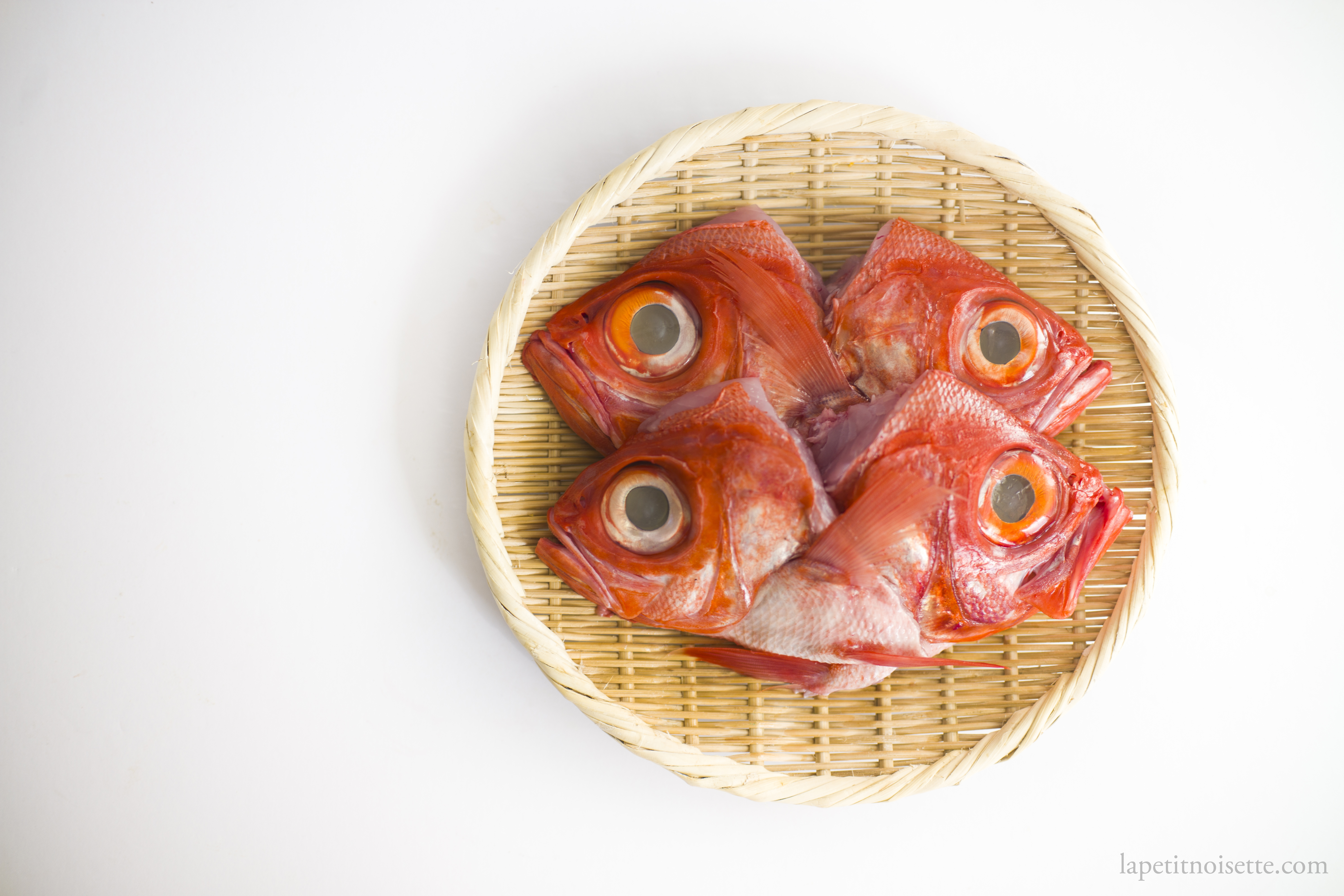
Sake Simmered Kinmedai Head 金目鯛頭の煮付け
- 2 Kinmedai heads
- 200ml Dashi
- 70ml Mirin
- 70ml Izumo Jidenshu Sake or substitute with 50% sake and 50% chinese cooking wine
- 65ml of good quality soy sauce, taste when the dish is done and adjust to taste.
- Mitsuba parsley for garnish
- 10g of sugar (Optional)
- Sliced ginger (Optional)*
*We added ginger when we made this dish for staff meal but when making the dish for customers, ginger was not added to allow the flavours of the fish to be forefront. I recommend eating this dish with a bowl of piping hot rice with some yuzu kosho.
- Reserve kinmedai heads when filleting the fish. Instructions can be found here.
- Use a scissors to cut out any remaining gills in the fish head.
- Scrub away any visible blood inside the fish head cavity. It is alright to do this under running water.
- Place the fish head on a chopping board standing up so that the fish mouth is facing towards the sky. With the knife blade facing towards the mouth and the dull edge facing towards the forehead, insert the knife into the forehead, through as deep as possible and split the head into half by bringing the knife down and cutting through the mouth lips and jaws. The front half of the fish head should now be split in two.
- Once the previous cut is complete, turn the knife to the opposite direction with the blade of the knife facing the forehead, press the knife down to completely split the head in two.
- Bring a large pot of water to a boil and blanch the fish heads quickly for 15 to 20 seconds before transferring the heads to an ice bath. Alternatively, place the split heads facing upwards on a colander and pour boiling water over them before running under cold water.
- Use your fingers to pick away any remaining scales on the fish heads which should be loosened now.
- Add the water, mirin and sake to a pot and bring to a boil.
Flambé the mixture to get rid of any additional alcohol from the sake and mirin. - Continue to reduce the mixture slightly for 2 to 3 minutes, before adding the fish heads (and ginger if adding).
- Cover the fish heads with the drop lid and cook over high heat for 5 minutes. The sauce should continue to evaporate during this 5 minutes.
- Add the soy sauce and bring back up to a boil for another 3 to 4 minutes before removing the drop lid and basting the sauce over the fish heads.
- At this point, taste the sauce. If it’s still too dilute to your taste, continue to reduce without the drop lid. I usually reduce the sauce until it’s a quarter of the original volume. Otherwise, balance out any bitterness with a little sugar or more soy sauce.
- Serve the dish with a garnish of mitsuba parsley. If you’re worried about the fish overcooking, you can take the fish out of the simmering liquid and reduce the sauce, before adding them back in at the very end for a last baste with sauce.
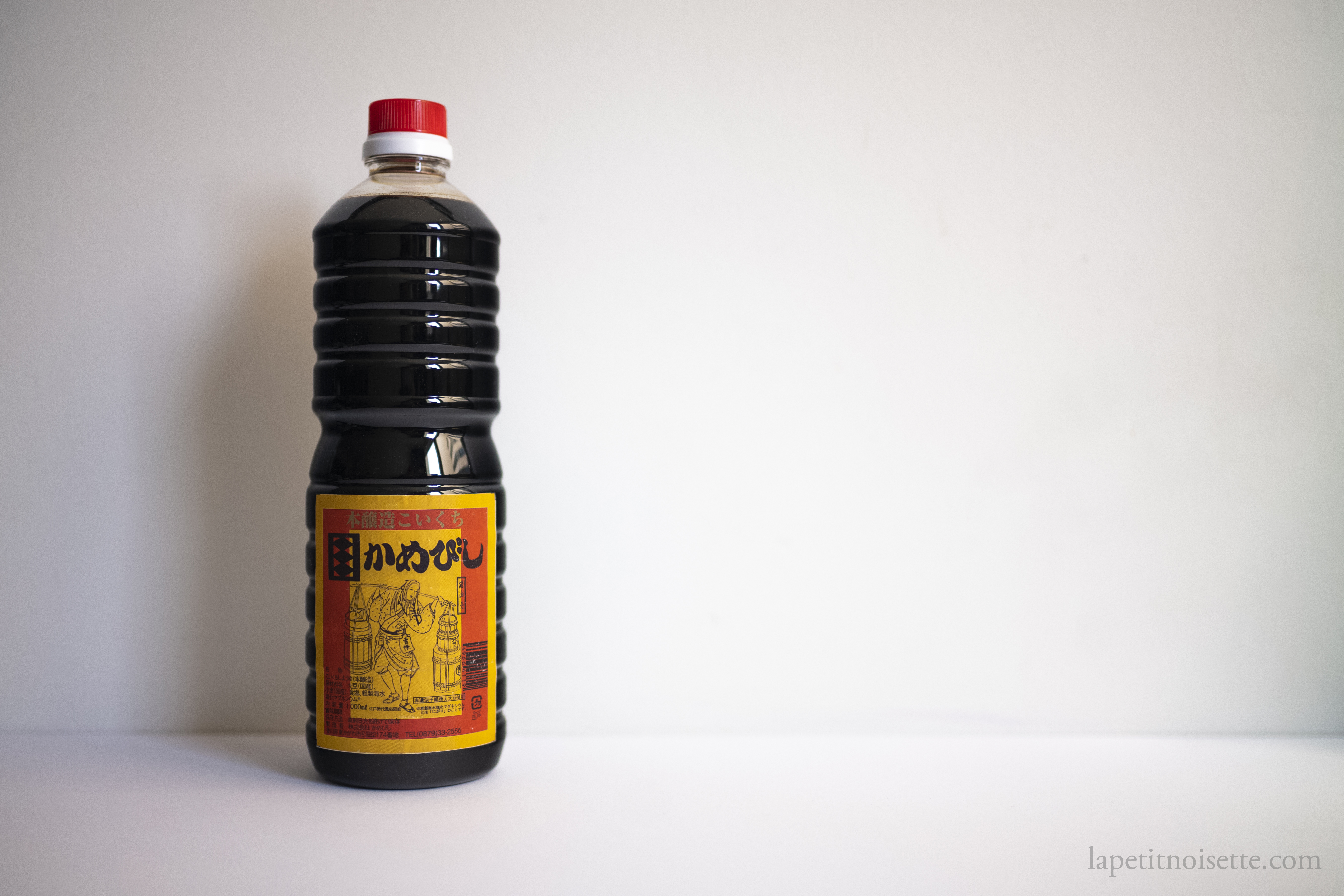
Notes:
Such a large amount of mirin and sake in the dish can make the sauce quite sweet so just watch out for that when making this dish. That’s why this dish calls for good quality soy sauce which is typically aged for a much longer time and has the concentration to stand up to the sweetness. I’d avoid Chinese soy sauce for this dish as some widely available ones have added sugar in them.
